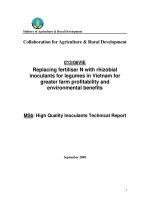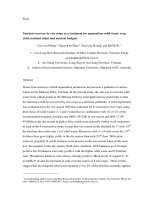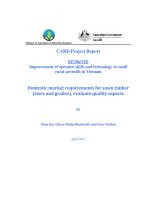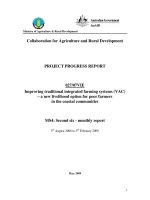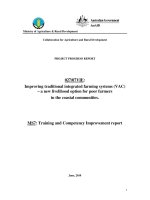Báo cáo khoa học nông nghiệp " Recommendations for vegetables 12 months between fruit and vegetable programs Metro Cash and Carry and Quynh Luong commune " pdf
Bạn đang xem bản rút gọn của tài liệu. Xem và tải ngay bản đầy đủ của tài liệu tại đây (295.25 KB, 25 trang )
1
Project 021-06VIE Training Assessment
Activities – 2007
Date Training Details Type
(FFS/TOT/Other)
Number
trained
Measurable outcomes
18
th
July Field workshop on assessing watermelon crop
establishment and growth issues at ASINCV Vinh City
TOT 10 10 ASINCV staff able to identify root disease
and watering issues on watermelons
20
th
July Presentation watermelon production – ASINCV July 20
th
TOT 25 ASINCV staff and Hung Dong commune
15-22
nd
July
Watermelon Workshop: Dr Rogers conducted workshops
in Vinh City (Hung Dong Collective) on how to produce
watermelons under GAP principles and to review year 1
watermelon trial results.
TOT 33 ASINCV vegetable staff aware of watermelon
production issues.
28
th
Oct –
4
th
Nov
Cabbage Workshop: Dr Rogers presented workshop at
Quynh Luong between 28
th
October and 4
th
November
2007 on safe cabbage production techniques and to
oversee planting operations.
TOT 31 Successful production of cabbage in Quynh
Luong and supply to Metro Hanoi
28
th
Oct –
4
th
Nov
Cabbage Workshop: Dr Rogers presented workshop at
Vinh City between 28
th
October and 4
th
November 2007
on safe cabbage production techniques and to oversee
planting operations.
TOT 24 Successful production of cabbage in Hung Dong
and supply to Metro Hanoi
October
November
Cabbage production FFS techniques: seedling production,
planting, production, harvesting and handling - Quynh
Luong – ASINCV staff
FFS 35 Supply of 50 tonnes of high quality, clean
cabbage to Metro Hanoi.
October
November
Cabbage production FFS techniques: seedling production,
planting, production, harvesting and handling - Hung
Dong (Vinh City) – ASINCV staff
FFS 21 Supply of 50 tonnes of high quality, clean
cabbage to Metro Hanoi.
1
st
October Training on cabbage agronomic techniques at ASINCV by
Gordon Rogers
TOT 15 ASINCV vegetable staff updated on cabbage
agronomy techniques
December Field training in postharvest handling and monitoring
techniques at QL and HD (Vinh City) – Dr Jobling and
ASINCV staff
TOT 32 Supply of quality cabbage to Hanoi and local
market.
2
5
th
December
Integrated Pest Management (IPM) and post harvest
workshops were run at Quynh Luong. Dr Jobling.
TOT 33 Farmers using Integrated Pest Management
(IPM), a GAP principle, thus crops in excellent
condition. Farmers have kept written records in
booklets specially prepared as the first step to
developing and on farm QA system
6
th
December
Integrated Pest Management (IPM) and post harvest
workshops were run at Vinh. Dr Jobling.
TOT 25 Farmers using Integrated Pest Management
(IPM), a GAP principle, thus crops in excellent
condition. Farmers have kept written records in
booklets specially prepared as the first step to
developing and on farm QA system
3-5
th
December
Vietnamese (5) and Australian (1) collaborators attended
GAP training workshop in Hanoi 3 - 5
th
December 2007
for tomato and cucumber production.
TOT 6 Many principles discussed at this meeting were
also relevant to cabbage and watermelon and will
be included in the GAP manuals produced for
this project.
12
th
– 18
th
August
Two Vietnamese scientists from ASINCV visited
Australia. The scientists visited Australian growers and
markets. They also worked with the Australian partners to
develop aspects of the GAP manual and particularly the
quality assurance aspects based on the NSW Department
of Primary Industries FreshCare
®
program.
Overseas Training 2 Principles incorporated into VietGAP best
practice guide
3
Activities – 2008
Date Training Details Type
(FFS/TOT/Other)
Number
trained
Measurable outcomes
14
th
-22
nd
January
Marketing training by John Baker presented at Quynh
Luong, Vinh city and in store promotion at Metro Thang
Long. John Baker made presentations to Metro staff on
handling and promotion on 21
st
January 2008.
TOT 65 Stickers for the cabbages have been printed to
highlight that they have been produced in a
“clean” way. Marketing plan developed and
submitted with milestone 4.
16
th
January
A training workshop was held at ASINCV on 16th January
2008 on harvesting, postharvest handling and marketing at
ASINCV in Vinh City.
TOT 15
13–21
st
January
Dr Jobling explained and demonstrated how to correctly
harvest and select first quality cabbages at Quynh Luong
TOT 33 Quality cabbage supplied to Hanoi
13–21
st
January
Dr Jobling explained and demonstrated how to correctly
harvest and select first quality cabbages at Hung Dong,
Vinh City.
TOT 21 Quality cabbage supplied to Hanoi
22
nd
January
Follow up workshops on GAP-compliant cabbage:
harvesting, postharvest, marketing and transport were
conducted at Vinh
TOT 21 Supply of 50 tonnes of high quality cabbage to
Metro Hanoi and also supplied local market in
Vinh
23
rd
January
Follow up workshops on GAP-compliant cabbage:
harvesting, postharvest, marketing and transport were
conducted at Quynh Luong
TOT 33 Supply of 50 tonnes of high quality cabbage to
Metro Hanoi and also supplied local market in
Vinh
2
nd
– 4
th
April
Dr Rogers present a paper on the project to the Fresh
Produce Vietnam conference in Ho Chi Minh City (2008) .
In addition, Dr Chuong and Mr Cuong were invited to
attend the conference.
TOT 3 Presentation submitted to CARD
5
th
June Marketing presentation to Mr Thai and other fresh produce
staff at Metro Thang Long. Hanoi.
TOT 10 Marketing plan submitted to CARD
3
rd
June John Baker Developed marketing plans for watermelons
with farmers and Metro, Hanoi and presented at Quynh
Luong.
TOT 33 Marketing plan submitted to CARD
3
rd
June John Baker Developed marketing plans for watermelons
with farmers and Metro, Hanoi and presented at Dien
TOT 40 Marketing plan submitted to CARD
4
Phuong
4
th
June John Baker Developed marketing plans for watermelons
with farmers and Metro, Hanoi and presented at Hung
Dong, Vinh City
TOT 24 Marketing plan submitted to CARD
3
rd
June Each marketing workshop was followed by in-field
training by Mike Titley in the watermelon crops being
grown at Quynh Luong.
TOT 33 Report submitted with milestone 8
3
rd
June Each marketing workshop was followed by in-field
training by Mike Titley in the watermelon crops being
grown at Dien Phuong.
TOT 40 Report submitted with milestone 8
4
th
June Each marketing workshop was followed by in-field
training by Mike Titley in the watermelon crops being
grown at Hung Dong, Vinh City.
TOT 24 Report submitted with milestone 8
4
th
June Workshop was help by Mike Titley on IPM and
watermelon crop management. ASINCV and MARD staff
attended.
TOT 15
June - July FFS on watermelon production and marketing one at the
Agricultural Science Institute of Northern Central Vietnam
(ASINCV) at Vinh
FFS 24 Report submitted with milestone 8
June - July FFS on watermelon production and marketing one at
Quynh Luong and included five women farmers
FFS 33 Report submitted with milestone 8
June - July FFS on watermelon production and marketing one at Dien
Phuong Commune
FFS 38 Report submitted with milestone 8
September
October
Farmer Field Schools were conducted weekly by ASINCV
staff to cover all stages of cabbage production from the
production of bare-rooted seedlings, soil preparation,
fertilizer application, planting, irrigation, pest and disease
control (IPM), harvesting, record keeping, postharvest
handling, and marketing. Quynh Luong
FFS 32 Successful supply of cabbage crop to Metro
Hanoi and local markets
September
October
Farmer Field Schools were conducted weekly by ASINCV
staff to cover all stages of cabbage production from the
production of bare-rooted seedlings, soil preparation,
fertilizer application, planting, irrigation, pest and disease
control (IPM), harvesting, record keeping, postharvest
handling, and marketing. Hung Dong, Vinh City
FFS 29 Successful supply of cabbage crop to Metro
Hanoi and local markets
5
September
October
Farmer Field Schools were conducted weekly by ASINCV
staff to cover all stages of cabbage production from the
production of bare-rooted seedlings, soil preparation,
fertilizer application, planting, irrigation, pest and disease
control (IPM), harvesting, record keeping, postharvest
handling, and marketing. Dien Phuong commune
FFS 36 Successful supply of cabbage crop to Metro
Hanoi and local markets
22
nd
Sept
– 3
rd
Oct
Cabbage Workshop: Dr Rogers visited between 22
nd
September and 3
rd
October 2008 and presented workshops
at Vinh City and Quynh Luong Commune on safe cabbage
production, and reviewed plans for the coming season. He
also visited Metro Hanoi to review supply requirements.
Cabbage variety demonstration trials which were set up at
Quynh Luong and Hung Dong and used as by farmers to
assist in variety selection.
TOT 33+21 High quality cabbage supplied to Hanoi and local
markets
10
th
– 17
th
December
John Baker and Gordon Rogers visited 10
th
– 17
th
December 2008 to conduct workshops on harvesting,
supply and marketing and planning of crop supply
schedules to fine-tune supply for the coming season.
Current plantings and supply schedules were reviewed for
cabbage, watermelon, carrots, tomatoes and Chinese
cabbage
TOT 51 Supply models developed. Expansion of the
number from crops being supplied to Metro from
Quynh Luong from 2 to 5 to include carrots,
tomatoes and Chinese cabbage.
February Three scholars from ASINCV Mr. Canh, Ms. Quyen and
Mr. Thang visited Australia in February 2008. They
visited farms, retailers and marketers in Australia and
attended the Australian Melon Conference in Ipswich,
Queensland during their visit.
Overseas Training 3
6
Activities – 2009
Date Training Details Type
(FFS/TOT/Other)
Number
trained
Measurable outcomes
7
th
March
Review supply of cabbage and other crops to Metro Hanoi
and to local markets. Assess cause and solution to bacterial
soft rot problems with cabbage crops and follow up with
training activities at ASINCV. Develop a new crop supply
plan from Nghe An to Metro. John Baker, Jenny Jobling,
Gordon Rogers
TOT 25
Cabbage supplied to Metro Hanoi and local
markets from March to April 2009. See report
attached to milestone 10.
9
th
March A training course on GAP for vegetables was conducted
by John Baker and Gordon Rogers at ASINCV in Vinh
during March 2009. The course focussed harvesting and
transport of watermelons for the coming summer 2009
season.
TOT 25 New cropping plan developed for 2009
April-May FFS run at Quynh Luong commune. The topics of the
courses were aspects of safe vegetable production for
watermelon. The topics were focussed on agronomic best
practice and harvesting for watermelon production and
were conducted by ASINCV staff.
FFS 30 High quality crops including watermelon,
cabbage, Chinese cabbage, carrots and tomatoes
now being supplied to Hanoi and local markets
April-May FFS run at Hung Dong communes. The topics of the
courses were aspects of safe vegetable production for
watermelon. The topics were focussed on agronomic best
practice and harvesting for watermelon production and
were conducted by ASINCV staff.
FFS 22 High quality crops including watermelon,
cabbage, Chinese cabbage, carrots and tomatoes
now being supplied to Hanoi and local markets
14
th
May A training course on IPM for vegetables was conducted by
Tim Kimpton at ASINCV in May 2009 focussing
developing and implementing IPM and IDM (Integrated
Disease Management) for both watermelon and cabbage
production. This was attended by ASINCV staff, Quynh
Luong and Hung Dong commune staff.
TOT 45 New disease control program developed and
submitted to CARD. Report submitted with
milestone 9
July-
August
FFS run at Quynh Luong commune. The topics of the
courses were aspects of safe vegetable production for
watermelon. The topics were focussed on agronomic best
FFS 31 High quality crops including watermelon,
cabbage, Chinese cabbage, carrots and tomatoes
now being supplied to Hanoi and local markets
7
practice and harvesting for cabbage production and were
conducted by ASINCV staff.
July-
August
FFS run at Hung Dong commune. The topics of the
courses were aspects of safe vegetable production for
watermelon. The topics were focussed on agronomic best
practice and harvesting for cabbage production and were
conducted by ASINCV staff.
FFS 23 High quality crops including watermelon,
cabbage, Chinese cabbage, carrots and tomatoes
now being supplied to Hanoi and local markets
September FFS run at Quỳnh Lương commune. The training focussed
on the production of cabbage. Topics included the
planning of vegetable supply to the market (scheduling), a
review of agronomic best practice and harvesting
techniques. The training was conducted by ASINCV staff.
FFS 30 FFS was run by ASINCV staff using the
VietGAP manuals as a guide to material covered.
Mr Giap led the fieldwork and agronomy, crop
planning and harvesting. Mr Hai presented
material on agronomy.
September FFS run at Hưng Đông commune. The training focussed
on the production of cabbage. Topics included the
planning of vegetable supply to the market (scheduling), a
review of agronomic best practice and harvesting
techniques. The training was conducted by ASINCV staff.
FFS 21 FFS was run by ASINCV staff using the
VietGAP manuals as a guide to material covered.
Mr Giap led the fieldwork and agronomy, crop
planning and harvesting. Mr Hai presented
material on agronomy.
18
th
November
GAP launch at VAS office in Hanoi TOT 50 VietGAP manuals launched and associated
technical presentations.
19
th
November
GAP Launch and training at Quynh Luong commune,
Quynh Luu
TOT 45 VietGAP manuals launched and training given on
their use
20
th
November
GAP Launch and training at Vinh City. ASINCV staff, QL
representatives and HD farmers and staff.
TOT 61 VietGAP manuals launched and training given on
their use. Quynh Luong commune leader (Mr
Sao) said farmers now financially better off (sales
and higher prices) and healthier because they are
not handling toxic chemical.
Vietnam Project Report
Marketing Report March 2009
Cabbage
1. Harvest was delayed because of flooding, so supply did not start until after Tet, when prices are
traditionally lower
2. Initial deliveries were:
o 5 February - 5,255 kg at 3,500 Dong/kg
o 12 February – 4,822 kg Price not known
o 23 February – 3,449 kg at 2,500 Dong/kg
3. For the three subsequent harvests the price was very low (1,000 Dong/kg), so farmers either sold
to local collectors or ploughed in the crops
4. Thai said the quality was not good, because the heads were soft
5. Production data is being recorded for the project and good information was shown by Mr. Cuong.
The data will be supplied in English to the project leader.
6. Cabbage still scheduled to be harvested (and Cuong undertook to confirm the schedule, plus
whether the timing is earlier than scheduled, and if the 27 April entry is correct ) is as follows,
with significant volume in late March/early April:
Harvest Date Source Volume (tonnes)
15 March Quynh Luong (QL) 3.7
20 March QL 2.5
25 March QL 3.5
29 March Hung Dung (HD) 3.5
30 March QL 3.8
4 April HD 1.8
5 April QL 4.0
27 April HD 1.5
Note: 13.1 tonnes forecast between 29 March and 5 April
7. When presented with the data, Thai undertook to recommence supply, with a small order to be
placed next week. This was an excellent outcome from the meeting. Prices should increase in
April, when local (Hanoi) production normally ends
8. ACTION:
o Cuong to confirm cabbage volumes and timing, plus check if 27 April harvest is correct
o Cuong to translate the production data into English and forward to Gordon
Watermelon
1. Production is forecast to commence in early April and continue to July, totalling around 100
tonnes, with supply from three communes, as follows:
Harvest Date Source Volume
5 April Dien Phong (DP) new 6
10 April DP 6
18 April DP 9
25 April DP 9
7 May Quynh Luong (QL) 5
14 May QL 5
18 May QL 5
25 May QL 5
1 June QL 5
8 June QL 5
15 June QL 5
June - July New site south 1 hectare: 30 tonnes
2. Farmers were very happy with the results and prices from last season (and are still happy)
3. The estimated production schedule (volume and timing) was presented to Thai, who said he
can take all the production, for sale through the three Metro stores in the north
4. The opening price offered by Thai was 7,000 Dong/kg, which is up significantly on last
year’s good prices, so the farmers should be even happier. Poor quality from the Mekong
Delta is a helpful factor
5. Poster and fruit labels were requested by Metro to be used again, to help promote the sales of
the watermelons In-store sampling of the melons will also be undertaken by Metro
6. ACTION:
• Cuong to provide contact details to Thai for new supply communes at Dien Phong and
south of Vinh, who are both growing watermelons for the first time
• Cuong to order more watermelon stickers for the fruit
• John to arrange for three new watermelon posters and send to Thai
Tomatoes
1. Quality was good but prices were too low for farmers
2. Thai said best prices are normally in summer – April to October, when the main supply is
from China
Chinese Cabbage
1. Farmers planted the wrong variety (even though Cuong offered to supply them with the
correct seed) , so metro did not accept the product
2. Thais said there is good potential if the correct variety is grown (like that in Dalat and
Australia) – long and bulky
Carrots
1. Returns were too low for the farmers. It is not clear why. The wrong variety may have been
the problem again, as Metro want big blocky carrots
2. There is also a need to look at when prices are highest (this information was not obtained
from Thai at the time), then check if it is feasible to grow to supply at this time of year
3. ACTION: John to check with Thai when carrot prices are best
Continuity on Project Completion
1. Both the farmers and Metro are keen for the relationship to continue after the project
finishes at the end of the year
2. A suggestion strongly supported by both Cuong and Thai was to hold “transition”
workshops for each of the participating farmer groups, covering production, scheduling
and recording, coordinating communication and supply with Metro etc. Suggested timing
was late September/October, prior to the next main round of plantings. Thai offered to
participate in the workshops. The workshop for Hung Dung commune could be held at
the Institute, so staff would also benefits by learning new skills
3. The on-going role of the Institute in coordination, quality supervision, residue testing etc,
needs to be determined, as these are all important components for the future success for
the farmers
4. Thai was also keen to work with the farmers in the potential new production high altitude
area near the Lao border, if the ACIAR project proposal is approved. This could add to
both timing of supply and diversity of crops.
John Baker
March 2009
Recommendationsforvegetables12monthsbetweenfruitand
vegetableprogramsMetroCashandCarryandQuynhLuongcommune
Background
TheQuynhLuongcommunehasbeenparticipatingintheprojectCARDVIE06‐021sinceits
inceptionin2006anduntilnow,haveasocialseasonproductionofcabbage,providing28
tonsamonthbetweenMayand2007,andabout50tonsofwatermelonsbetweensix
months‐July2008.
Keyfeaturesofthearrangementisthedepthsupportedavailabletoparticipantsand
mutualinterestinestablishingeffectiverelationshipsbetweenlong‐termMetroCashand
Carry,andgrowerorganizationsasQuynhLuongcommune.Theideatobuildthe
relationshipmutuallybeneficialtoprovideanewinitiativeforbothMetroandfarmers,
but
itisthebasisoftheeffectivenessoffreshproducesupplysystemsthroughoutthe
developingworld.
RelationshipissupportedbytheInstituteofAgriculturalScienceofNorthCentralVietNam
(ASINCV)andthroughprojectsVIE06CARD‐021,oftheUniversityofSydney,horticultural
researchandapplicationsspecialistsPtyLtd
consultantssuchasMr.JohnBaker,marketing
specialist
Mr.Thai,managementoffreshproduce,supportedstronglyaboutbuildinglong‐term
linkageswithfarmersgroupssuchasQuynhLuongcommune.
Recommendationsforcropstoprovide12monthsfromQuynhLuongCommune
Crop
Start and end the
harvest
Startof
Planting
Yield
comments
Cabbage MidDec–endApr EarlyOct 50
Chinese
Cabbage
MidDec–endApr EarlyOct
Tomatoes
StartDec–endJuly MidSep
Watermelon StartMay–midAug MidMar 50+
Susu StartFeb–endApr ?
Carrots
StartDec–endApr EarlySep
Crop Jan Feb Mar Apr May Jun Jul Aug Sep Oct Nov Dec
Cabbage
Chinese
Cabbage
Tomatoes
Watermelon
Susu
Carrots
SupplyscheduleofvegetableproductsforMetro2009‐2010(VIE021/06Project)
Table1.TotalVegetables(Cabbage,TomatoandChinesecabbage)
Supplyschedulefrom20Jan.2010to15March2010.
Harvesting
Order
Estimatetransport
datetoMetro
Cabbage(tonne) Tomato(tonne)
ChineseCabbage
(tonne)
Total(tonne)
1 20/01/10 6.0 0.0 0.0 6.0
2 26/01/10 4.0 0.5 1.0 5.5
3 01/02/10 6.0 0.0 0.0 6.0
4 03/02/10 4.0 0.5 1.0 5.5
5 05/02/10 6.0 0.0 0.0 6.0
6 08/02/10 6.0 0.0 0.0 6.0
7 10/02/10 4.0 0.5 1.0 5.5
8 12/02/10 6.0 0.0 0.0 6.0
9 17/02/10 4.0 0.5 1.0 5.5
10 19/02/10 6.0 0.0 0.0 6.0
11 21/02/10 4.0 0.5 1.0 5.5
12 25/02/10 6.0 0.0 0.0 6.0
13 01/03/10 4.0 0.5 1.0 5.5
14 08/03/10 4.0 0.5 1.0 5.5
15 15/03/10 4.0 0.5 1.0 5.5
Total 74 4 8 86
Table2.Detailsoftransplantsandyieldofeachharvestingtime.
No. Plantingdate Area(m
2
) Harvestdate Yield(tonnes) Note
01/11/09 1250 26/01/10 4.0 Include0.5tonneoftomatoand1.0
08/11/09 1250 03/02/10 4.0 tonneofChinesecabbagepereach
15/11/09 1250 10/02/10 4.0 transporttimewhenpossible
22/11/09 1250 17/02/10 4.0
29/11/09 1250 21/02/10 4.0
06/12/09 1250 01/03/10 4.0
13/12/09 1250 08/03/10 4.0
Cabbage(Quynh
Luong–NgheAn)
20/12/09 1250 15/03/10 4.0
26/11/09 500 26/01/10 1.0
03/12/09 500 03/02/10 1.0
10/12/09 500 10/02/10 1.0
17/12/09 500 17/02/10 1.0
21/12/09 500 21/02/10 1.0
01/01/10 500 01/03/10 1.0
08/01/10 500 08/03/10 1.0
ChineseCabbage
(QuynhLuong)
15/02/09 500 15/03/10 1.0
26/01/10 0.5
03/02/10 0.5
10/02/10 0.5
17/02/10 0.5
21/02/10 0.5
01/03/10 0.5
08/03/10 0.5
Tomato(Quynh
Luong)
15/03/10 0.5
30/10/09 2500 20/01/10 6.0
07/11/09 2500 01/02/10 6.0
Cabbage(Hung
Dong)
15/11/09 2500 08/02/10 6.0
07/11/09 2500 05/02/10 6.0 Toencourageagriculturalexpansion
20/11/09 2500 19/02/10 6.0 (VinhCity)
15/11/09 10.000 12/02/10 6.0
Cabbage
(HaTinh)
25/11/09 10.000 25/02/10 6.0
Total 86.0
Fungicide Activity Key Diseases
Suitable Foliar Fungicides for Watermelon Crops
NB: "Suitable" fungicides are very LIKELY to be both effective and safe to the crop but not necessarily evaluated or confirmed to be so in watermelons.
These products are not necessarily "Registered" for these uses in an specific country, though many are likely to be.
Product Active Ingredient Group
Powdery
Mildew
Downy
Mildew
Gummy
Stem
Blight
Alternari
a Comments
Spin Flow (Bavistin) carbendazim A *
Amistar azoxystrobin K *** ** ** ****
Cabrio pyraclostrobin K **** *** ** ****
Flint trifloxystrobin K **** * ? ?
Nimrod bupirimate H **
Bayfidan triadimenol C ** ? *
Excellent activity but very short
lived residual protection
Topas penconazole C *** ? *
Mycloss myclobutanil C *** ? *
Tilt propiconazole C ** ? *
Score difenconazole C * ***(*)
Folicur tebuconazole C ** ? **
Ridomil metalaxyl-m (mefanoxam) D ****
Available formulations are nearly
ALWAYS coformulated with a
group Y protectant fungicide
Bravo (Daconil) chlorothalonil Y ** ** **
Dithane mancozeb Y *(*) * *(*)
Agri-Fos 400 Phophorous Acid Y *** Result highly dependent on timing
Cu - hydroxide, oxychloride Cu Y **
Sulphur S Y **(*)
Prosper spiroxamine Y **(*)
Legend quinoxyfen Y **(*)
Filan boscalid ? ? ? ****
A new and very active fungicide on
a very broad range of pathogens
Product labels for ALL fungicides registered for use in Australia can be found at:
/>
Products may be searched for by active ingredient or product name. Crop (situation) is also searchable.
Important note: Many products will be highly effective against diseases in crops NOT on Australian labels.
This is mainly due to the cost of doing the work to register products for legal use in minor (small) crops being too high for the applicant.
However, in Australia a PERMIT system tries to address the problem largely by allowing specific uses of specific products where a clear need and no available
legal alternatives exist.
These permits allow the use of specific chemicals at specific rates, numbers of sprays and application intervals for a FINITE period of time.
Permits are also searchable by product, active ingredient or crop and can be found at:
/>
Dry Season Program
1. As powdery and downy mildew tend to favour different conditions, product selection is likely to differ between extreme WET and DRY
seasons.
2. However, extreme susceptibility to both diseases in cucurbit crops means that both may occur in the same crop, particularly during
transitional weather periods.
3. Powdery mildew is likely to become much more important than downy mildew during drier weather.
4. In these (drier) periods, expensive and high activity downy mildew sprays can likely be replaced with higher efficacy powdery mildew
sprays.
5. Higher efficacy powdery mildew sprays that should also be relatively inexpensive are the Group C (triazole) fungicides, particularly:
6. BAYFDAN (triadimenol), MYCLOSS (myclobutanil) & TOPAS (penconazole).
7. These should be applied at first sign of disease and a repeat application made 14 days later.
Wet Season Low Cost Program
Timing Product Active Ingredient(s) Activity against
Week 0
Week 1
Week 2
Week 3
Week 4 Daconil 500 SC chlorothalonil Downy mildew, Alternaria, GSB
Week 5 Kocide Blue Xtra Cu hydroxide Downy mildew
Agri-Fos 400 phosphonic acid Downy mildew
Week 6 Score difenoconazole Alternaria, GSB, Powdery mildew
Daconil 500 SC chlorothalonil Downy mildew, Alternaria, GSB
Week 7 Kocide Blue Xtra Cu hydroxide Downy mildew
Agri-Fos 400 phosphonic acid Downy mildew
Week 8 Daconil 500 SC chlorothalonil Downy mildew, Alternaria, GSB
Wet Season Standard Program
Timing Product Active Ingredient(s) Activity against
Week 0
Week 1
Week 2
Week 3
Week 4 Ridomil Gold MZ metalaxyl-m Downy mildew
mancozeb GSB, Alternaria, Downy mildew
Week 5 Daconil 500 SC chlorothalonil Downy mildew, Alternaria, GSB
Week 6 Daconil 500 SC chlorothalonil Downy mildew, Alternaria, GSB
Score difenoconazole Alternaria, GSB, Powdery mildew
Week 7
Week 8 Ridomil Gold MZ metalaxyl-m Downy mildew
mancozeb GSB, Alternaria, Downy mildew
Week 9
Wet Season High Input Program
Timing Product Active Ingredient Activity against
Week 0
Week 1 Daconil 500 SC clorothalonil Downy mildew, Alternaria, GSB
Week 2 Daconil 500 SC clorothalonil Downy mildew, Alternaria, GSB
Week 3 Daconil 500 SC clorothalonil Downy mildew, Alternaria, GSB
Week 4 Ridomil Gold MZ metalaxyl-m Downy mildew
mancozeb GSB, Alternaria
Week 5 Amistar Top azoxystrobin Alternaria, GSB, Downy mildew
difenoconazole Alternaria, GSB, Powdery mildew
Week 6 Daconil 500 SC clorothalonil Downy mildew, Alternaria, GSB
Week 7 Amistar Top azoxystrobin Alternaria, GSB, Downy mildew
difenoconazole Alternaria, GSB, Powdery mildew
Week 8 Ridomil Gold MZ metalaxyl-m Downy mildew
mancozeb GSB, Alternaria
Week 9 Daconil 500 SC clorothalonil Downy mildew, Alternaria, GSB
Original Program (was working at Quynh Luong)
Timing Product Active Ingredient
Product Rate (/12 L
knapsack /600 m
2
)
Activity against
Week 0
Week 1
Week 2
Week 3
Week 4 Ridomil Gold MZ metalaxyl-m 50 g Downy mildew
mancozeb GSB, Alternaria, Downy mildew
Delan dithianon 20 mL Downy mildew, Alternaria, GSB
Week 5
Week 6 Delan dithianon 20 mL Downy mildew, Alternaria, GSB
Score difenoconazole 20 mL Alternaria, GSB, Powdery mildew
Week 7
Week 8 Ridomil Gold MZ metalaxyl-m 100 g Downy mildew
mancozeb GSB, Alternaria, Downy mildew
Week 9
Fungicide Rates (Vietnam)
PRODUCT Active Ingredient
Active Ingredient
Loading g/kg or
g/L
PRODUCT Use
Rate (g or mL/ha)
Active Ingredient
(g/ha)
g or mL of product per
12 L Knapsack per 500
m
2
(240 L/ha)
Ridomil Gold MZ
metalaxyl-m +
mancozeb 40 + 640 2500 100 + 1600 125
Daconil 500 SC chlorothalonil 500 2300-3600 1150-1800 115-180
Amistar Top
azoxystrobin +
difenoconazole 200 + 125 1000 200 + 125 50
Amistar 250 SC azoxystrobin 250 800-1200 200-300 40-60
Score 250 EC difenoconazole 250 300-500 75-125 15-25
Dithane Rainshield mancozeb 750 1700-2200 1275-1650 85-110
Delan dithianon 750 400 300 20
Disclaimer:
Above use rates are a guide only to typical application rates used globally.
Be sure to check the active ingredient loading in the product selected as these often vary between formulations.
Guide use rates may not accurately reflect most appropriate use rates or spray intervals for local conditions.
These products may NOT be registered for legal use in these crops.
Always refer to local manufacturers labels for appropriate use rates.
Fungicide Resistances
This is a complex area of discussion and beyond the scope of this Document.
In general, MULTI-SITED PROTECTANT fungicides (Group Y) are less prone to developing resistance than SINGLE-SITED HIGH
EFFICACY fungicides.
All fungicides with the same letter (see the first page of the label on all fungicides sold in Australia) should be regarded as the same for
resistance management.
The only exception to this are the Group Y fungicides - These are multi-sited and may involve different or unknow modes of activity.
As a guide only, the expensive highly effective products are the ones more at risk to the development of resistance. Particularly prone to
resistance are:
Group D fungicides - metalaxyl, metalaxyl-m, oxadixyl
Group K fungicides - azoxystrobin, pyraclostrobin, trifloxystrobin
As a result, the use of Group D & K fungicides should be minimised. They are often sold only in a mixture with a group Y protectant to
minimise the risk of resistance.
Suggested resistance management recommendations for crops in Australia can be found at:
www.croplifeaustralia.org.au/files/resistancemanagemen/fungicides/Fungicide%20Activity%20Group%20Table%20-%20150908
IMPORTANT: Australia is currently changing over from a local system of fungicide resistance classification to the global one.
This may cause some confusion while labels transit from the old to the new system.
The global classification system does not provide crop specific recommendations. However it may be useful an can be found at:
o/frac/index.htm
Alternative Fungicides
Product Alternative Products
Daconil (Bravo) Delan, Polyram, Dithane
Amistar Top Amistar 250 SC, Score, Cabrio, Aero, Pristine
Ridomil Gold Mz Rebound
Suggested Fungicide x Variety Trial
At the time this document was prepared (15 May 2009), a definitive diagnosis of the key disease(s) causing the most serious damage (premature
defoliation) had not been made.
At this point, visual examination of symptoms and examining the records of what fungicides and what varieties had been used, suggests the most likely
causal pathogens to be:
Alternaria or downy mildew. Less likely is gummy stem blight (Dydimella).
As a consequence of suspected differences in varietal tolerance (if Alternaria) or as a result of Ridomil Gold Mz being used only at the cleanest site,
there is a need to conduct a fungicide x variety trial.
This trial should include the 6 varieties:
Sumo
5758 Seems to be the most tolerant to disease
CS202
CN 46
HMN 027
HMN 134
THUY
LOI Widely grown local standard
The 3 fungicide
treatments should be:
1. WET SEASON - Low
Cost Program
2. WET SEASON -
Standard Program
3. WET SEASON - High
Input Program

